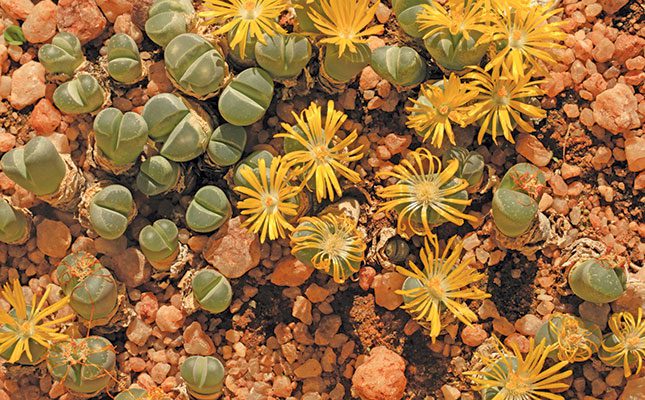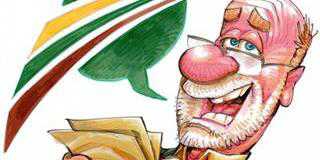
Photo: Glenneis Kriel
Succulent poaching is not a new problem in South Africa; collectors have been stealing our unique plants for decades. However, the scale of the trade in South Africa’s succulent plants is now unprecedented.
It was believed that COVID-19 travel restrictions would lead to a decrease in plant poaching, at least for a while. However, the World Wide Fund for Nature South Africa (WWF SA), and the South African National Biodiversity Institute (SANBI), have confirmed that the restrictions had the opposite effect.
Paul Gildenhuys, an enforcement specialist at Cape Nature, explains that sophisticated hobbyists used to be the prime perpetrators in the past. They usually came to South Africa, gathered the plants and then smuggled them out when they flew out of the country.
Since 2019, however, the trade has become syndicate-driven, with the same organisations involved in rhino, abalone and ivory poaching.
“Syndicates pounced on this opportunity by using their existing networks to satisfy
the demand, when collectors were unable to travel internationally,” says Gildenhuys. “Poor locals are mobilised to collect succulents at a pittance of what the end user pays, and instead of the poachers smuggling the succulents out of the country in their luggage, the plants are couriered overseas.”
China is the primary destination of poached succulents. Gildenhuys attributed this to the growth of the Chinese middle and upper classes, in combination with social media posts that generate a greater awareness of these plants and their unusual nature.
“We see attention shifting from one species to another as soon as commercial growers get the hang of producing specific species at scale. Despite this, even when some species are available commercially, some collectors are in search of something that has been rendered unique and strange by nature,” he says.
Whereas succulent poaching incidents used to occur once or twice every second to third year, the situation is now out of control, according to the conservation bodies. The Western Cape had one case in 2018, seven cases in 2019, 41 in 2021 and 36 in 2022. More than 15 cases have been reported in the province since the start of 2023.
Only one arrest was linked to succulent poaching in 2018, but this shot up to 116 in 2021 and 92 in 2022. But it is the quantity of plants stolen that has increased most of all. According to Gildenhuys, the number of seized plants increased from 1 381 in 2018 to over 240 000 in 2022.
SANBI estimates that the percentage of seized plant material in South Africa as a whole has increased by 200% annually over the past four years, and that more than 650 different species and about 1,2 million wild collected plants had been seized by May 2023.
While law enforcement and reporting of the illegal harvesting are making an impact, SANBI suspects that less than 25% of the trade is intercepted by enforcement officials, and more than 1,5 million plants have been removed from the wild over the past three years.
Species affected
The illegal trade is having a destructive impact on various succulent species. Ismail Ebrahim, project manager of Custodians of Rare and Endangered Wildlife at SANBI, says the number of Conophytum species, commonly known as button plants, listed as endangered increased from six in 2019 to 75 in 2022, while those listed as critically endangered increased from 16 to 86.

And where 51 of the plants were listed as “least concern” in 2019, no species remained in this category in 2022.
Ebrahim explains that many of the targeted species are extremely vulnerable because they grow only in the Succulent Karoo biome, stretching from Luderitz in Namibia down to the West Coast of South Africa and eastwards to the Klein Karoo in the Western Cape, and some occur only in single locations in this region.
The Succulent Karoo is home to just under 2 500 succulent plant species, representing around 100 genera found nowhere else on earth.
“With poachers stealing more than a thousand plants at a time, there is a real threat that one poaching incident could obliterate whole species. We’ve had incidents where the number of seized plants was more than we thought occurred in the wild.”
Keeping locations safe
Since the huge spike in poaching incidents, more care has been taken to keep the location of these species hidden and off the Internet. However, the various sources that have been published about South Africa’s succulents make it difficult to keep all these locations safe, says Ebrahim. Ecotourism has been identified as another vehicle for gathering intelligence on the location of plants.
Carl Brown, a compliance specialist at Cape Nature, says ecotourism contributes to succulent poaching because a tourist might innocently post photographs on social media where the location is easily identifiable, or provide a geolocation. Sometimes, collectors themselves will participate in tours to gather locality information for later exploitation.
The situation is exacerbated by what Ebrahim calls “plant blindness”.
“The level of awareness of succulent poaching is not as high as rhino or elephant poaching, as it’s much easier to generate emotion with photos of animals than with photos of plants.”
Katherine Forsythe, the project coordinator for the Leslie Hill Succulent Karoo Trust at WWF SA, says South Africa’s succulent species are not only unique, but many do not occur anywhere else in the world.
“These species are often more threatened and certainly worthy of similar attention to [that given to] large mammals.”
Plan of action
Government is aware of the problem, explains Forsythe. To address the situation, the Department of Environment, Forestry and Fisheries, with the support of various stakeholders, including SANBI and WWF SA, developed a national response strategy and action plan to combat the illegal trade of succulent flora in South Africa.
Government approved the strategy for implementation in March 2022. It has seven key objectives, ranging from ensuring the long-term survival of succulent populations representative of South Africa, to creating public awareness, to capacitating the enforcement sector to take more effective action against the illegal trade.
As part of the plan, SANBI is monitoring the status of wild-growing succulent species and conducting national conservation assessments to keep red-list status up to date.
Dr Carina Becker Du Toit, scientific coordinator at SANBI, explains that these assessments are important as they are used to rank the importance of seized succulents.
“We’ve been flooded with seized succulents over the past three years, and don’t have the manpower or space to save all the plants.
“We decide which plants to save based on the scarcity, age and size of the location where a plant grows. The system is complicated by the fast rate at which species are changing from not threatened to critically endangered, because of the large number of plants stolen at a time.”
The saved plant material is planted out in pots, with the long-term goal of re-establishing them in the wild. This, however, is far easier said than done, according to Becker Du Toit, as little knowledge is available about the cultivation and growing requirements of the different subspecies.
“While the survival rates of these plants are fairly high in nurseries, most don’t make it when replanted in their original habitat,” she says.
SANBI is also establishing off-site conservation collections that ensure genetically diverse repositories. Ebrahim points out that one of the species that has become extinct in the wild has been preserved this way.
Along with this, Conservation South Africa, as part of a joint project with SANBI, the Botanical Society of South Africa and Wilderness Foundation Africa, is hosting community workshops where members of the community are made aware of the impact of succulent poaching.
Becker Du Toit says succulent poaching threatens not only succulent species, but entire ecosystems due to the interdependence of plants and animal species on one another. In addition, these ecosystems are critical for supporting people’s livelihoods in these arid regions.
So far, five workshops, attended by 90 people altogether, have been conducted in regions identified as sensitive to succulent poaching.
Farmer support
How can farmers themselves help to save succulents? Ebrahim identifies access to land to monitor these species as one of their greatest challenges.
“We need to get on farms to see what is growing there and to update red-list species. It’s difficult to spot some of the genetic differences with an untrained eye. So farmers might be totally oblivious of the rarity of the succulents that grow on their farms.”
Ebrahim says he understands that, for security reasons, farmers are hesitant to allow strangers onto their farms. However, SANBI takes great care to treat all its findings as confidential.
While physical visits to monitor the plants are first prize, farmers can assist SANBI to keep track of species by sending the organisation photographs.
Farmers are also encouraged to help combat succulent poaching by reporting suspicious activities to their local stock theft units.
Ebrahim says many poachers have been caught thanks to alerts from members of
the public who were concerned about people taking photographs of succulents in isolated areas, or seeing unfamiliar people in areas where they should not be.
It helps if the public are constantly alert to this crime. Some courier companies,
for example, helped to catch poachers, when members of their staff noticed the perpetrators using boxes for toys to smuggle succulents to China.
Report any suspicious activity related to the illegal trade in indigenous succulent
plants to the nearest police station or conservation authority. Or contact the
Crime Stop tip-off line on 086 00 10111.
* We were briefed not to mention the names of individual species, not to use place names or photographs that would make it easy to identify the locations of species, and to avoid mentioning prices achieved for these species, as doing so could contribute further to illegal activities.













